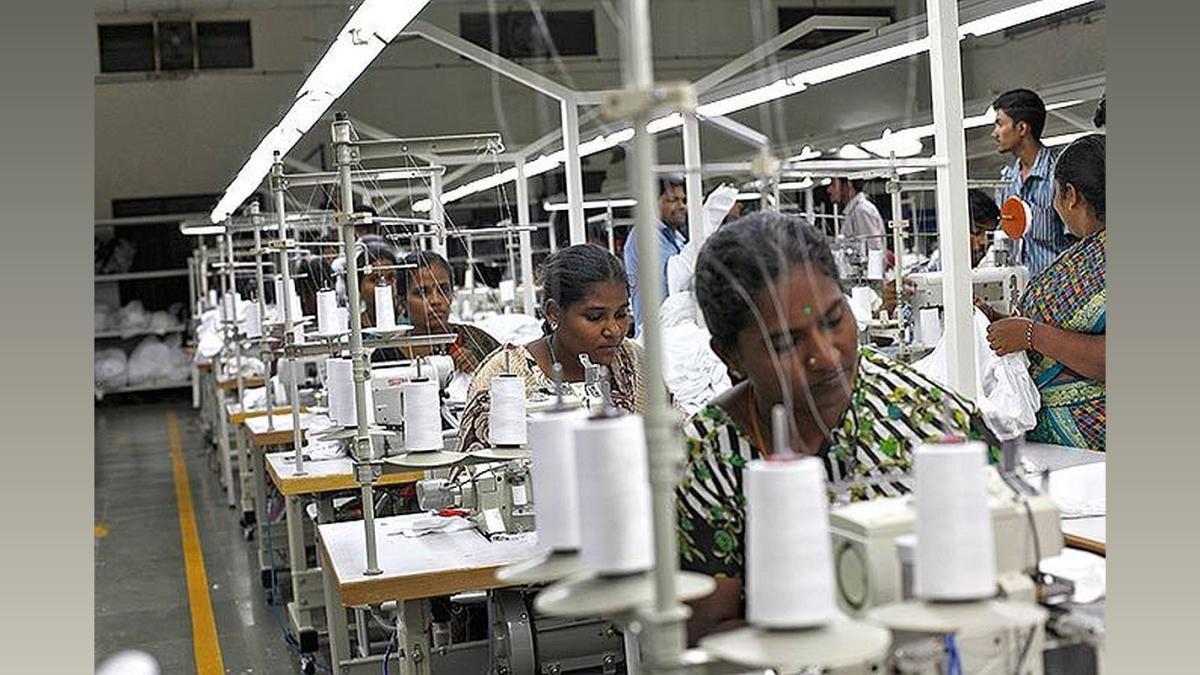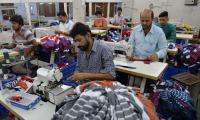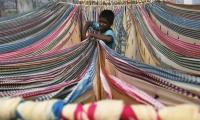India's Apparel Industry Struggles with Synthetics: GTRI Report
India's apparel industry lags behind in synthetic fabrics, impacting exports. GTRI highlights the need for increased focus on synthetics, weaving, processing, and compliance for industry growth.

Photograph: Mansi Thapliyal/Reuters
New Delhi, Feb 27 ( PTI) The developed countries are buying clothing made up of mixed synthetics and the Indian apparel industry is weak on that front, leading to a decline in global exports share, a report by GTRI said on Tuesday.
The Global Trade Research Initiative (GTRI) said that due to weak synthetics, India's apparel industry is a horse running with one leg tied.
"The results are low exports, low wages, and low investments in the sector," it said, adding that synthetics have overtaken cotton and become favourite of the fashion industry.
"70 per cent of clothing bought by developed countries is made of mixed synthetics. Their share in Indian exports is less than 40 per cent and this is the key reason for India's weak garment exports, the report said.
It added that today, most formal, sports and fashion wear uses synthetic fabrics. They are durable, do not fade, and can have any colour besides easy blending with wool, cotton, or rubber allows experimentation.
Explaining it further, the report said that globally cotton dominates spring and summer sales seasons, while synthetics and blends dominate autumn and winter seasons.
Indian units run six months a year to produce cotton apparel. In the remaining six months, most units are shut or run at a low capacity as they do not have orders for synthetics/ winter wear and most workers go home, it added.
"Also, a factory that runs only six months a year still has to pay the full year's fixed costs' rent, salary for minimal staff, interest on loans, etc. This makes anything made in the factory expensive. Absence from synthetics also affects workers' wages," it said.
It also said that since India is mainly an informal cotton-wear exporting country, wages remain at minimal levels.
Entry into synthetics would make factories run full year, and increase wages manifold.
"With less than 40 per cent of Indian textile exports being synthetic, despite developed countries' preference for such materials, India misses out on a substantial market segment. This also means failure of most Indian firms to connect to fast-moving textiles global value chains," it said.
Further, the report said that India's textile value chain, which includes yarn making, weaving, fabric processing, and apparel making, is weakened by its underdeveloped weaving and processing sectors.
These sectors are characterised by small, informal units lacking in expertise, scale, and technology. Issues such as power outages and underutilisation increase weaving costs in India to levels comparable with those in the EU or US.
Similarly, fabric processing in India faces challenges with smaller units processing far less cloth daily compared to their Chinese counterparts, it said.
Chinese units process 10 lakh metres of cloth a day, Indian units less than 20,000 metres, it said.
This capacity gap, along with batch processing methods that lead to inconsistent quality, and difficulties in meeting environmental standards like zero-liquid discharge (ZLD), further weakens the chain.
"This disparity results in India exporting yarn but importing fabric," the report said, adding that the yarn sector has large units while weaving and processing happen in small informal units.
Not surprisingly, while India is the number one yarn exporter (India 23 per cent share, China 13 per cent) when it comes to fabrics, performance falls (India 6 per cent, China 52 per cent).
"Setting up ten big-scale weaving and processing units could be an annual goal.
In 2023, India's garment exports were a mere USD 14.5 billion, significantly trailing behind China ( USD 114 billion), the EU (USD 94.4 billion), Vietnam (USD 81.6 billion), and even Bangladesh (USD 43.8 billion).
The report suggested that more and more domestic firms need to be Fast Fashion Industry Compliance as only 1,200 Indian factories are compliant with fast fashion industry standards.
It also asked for strengthening contract enforcement and easing rigid labour laws to help industry growth.
"To regain its textile glory, India must focus on enhancing synthetic apparel production, strengthening weaving and processing capabilities, becoming fast fashion compliant, negotiating non-tariff barriers, liberalising labour laws, and improving contract enforcement," it added.
The Global Trade Research Initiative (GTRI) said that due to weak synthetics, India's apparel industry is a horse running with one leg tied.
"The results are low exports, low wages, and low investments in the sector," it said, adding that synthetics have overtaken cotton and become favourite of the fashion industry.
"70 per cent of clothing bought by developed countries is made of mixed synthetics. Their share in Indian exports is less than 40 per cent and this is the key reason for India's weak garment exports, the report said.
It added that today, most formal, sports and fashion wear uses synthetic fabrics. They are durable, do not fade, and can have any colour besides easy blending with wool, cotton, or rubber allows experimentation.
Explaining it further, the report said that globally cotton dominates spring and summer sales seasons, while synthetics and blends dominate autumn and winter seasons.
Indian units run six months a year to produce cotton apparel. In the remaining six months, most units are shut or run at a low capacity as they do not have orders for synthetics/ winter wear and most workers go home, it added.
"Also, a factory that runs only six months a year still has to pay the full year's fixed costs' rent, salary for minimal staff, interest on loans, etc. This makes anything made in the factory expensive. Absence from synthetics also affects workers' wages," it said.
It also said that since India is mainly an informal cotton-wear exporting country, wages remain at minimal levels.
Entry into synthetics would make factories run full year, and increase wages manifold.
"With less than 40 per cent of Indian textile exports being synthetic, despite developed countries' preference for such materials, India misses out on a substantial market segment. This also means failure of most Indian firms to connect to fast-moving textiles global value chains," it said.
Further, the report said that India's textile value chain, which includes yarn making, weaving, fabric processing, and apparel making, is weakened by its underdeveloped weaving and processing sectors.
These sectors are characterised by small, informal units lacking in expertise, scale, and technology. Issues such as power outages and underutilisation increase weaving costs in India to levels comparable with those in the EU or US.
Similarly, fabric processing in India faces challenges with smaller units processing far less cloth daily compared to their Chinese counterparts, it said.
Chinese units process 10 lakh metres of cloth a day, Indian units less than 20,000 metres, it said.
This capacity gap, along with batch processing methods that lead to inconsistent quality, and difficulties in meeting environmental standards like zero-liquid discharge (ZLD), further weakens the chain.
"This disparity results in India exporting yarn but importing fabric," the report said, adding that the yarn sector has large units while weaving and processing happen in small informal units.
Not surprisingly, while India is the number one yarn exporter (India 23 per cent share, China 13 per cent) when it comes to fabrics, performance falls (India 6 per cent, China 52 per cent).
"Setting up ten big-scale weaving and processing units could be an annual goal.
In 2023, India's garment exports were a mere USD 14.5 billion, significantly trailing behind China ( USD 114 billion), the EU (USD 94.4 billion), Vietnam (USD 81.6 billion), and even Bangladesh (USD 43.8 billion).
The report suggested that more and more domestic firms need to be Fast Fashion Industry Compliance as only 1,200 Indian factories are compliant with fast fashion industry standards.
It also asked for strengthening contract enforcement and easing rigid labour laws to help industry growth.
"To regain its textile glory, India must focus on enhancing synthetic apparel production, strengthening weaving and processing capabilities, becoming fast fashion compliant, negotiating non-tariff barriers, liberalising labour laws, and improving contract enforcement," it added.
You May Like To Read
TODAY'S MOST TRADED COMPANIES
- Company Name
- Price
- Volume
- Vodafone-Idea-L
- 11.65 (+ 3.56)
- 106772451
- Alstone-Textiles
- 0.28 ( -3.45)
- 44187760
- Mangalam-Industrial
- 0.88 ( -2.22)
- 39177573
- Sunshine-Capital
- 0.27 (+ 3.85)
- 35956340
- GMR-Airports
- 104.40 (+ 6.37)
- 30453005






